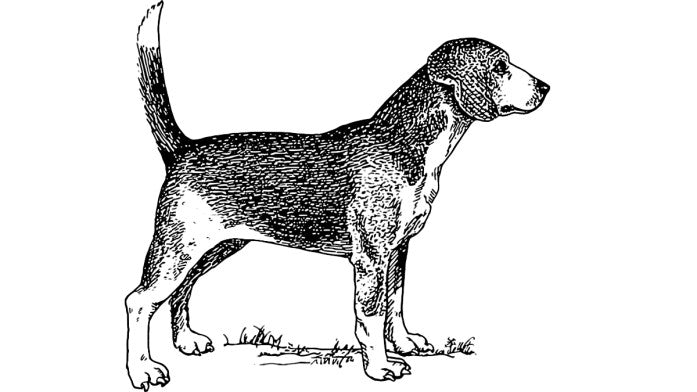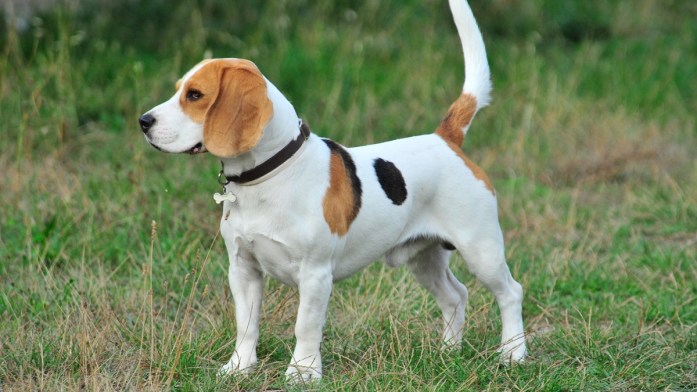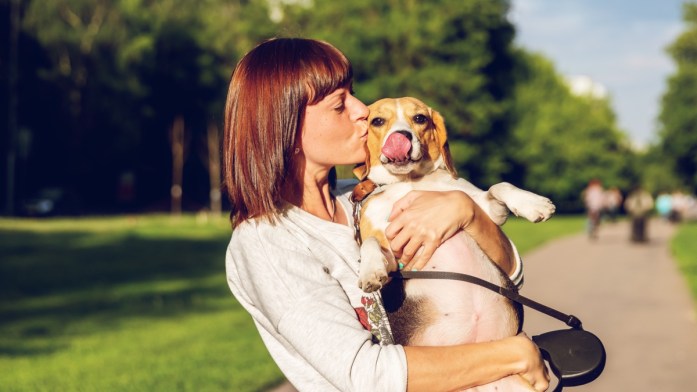A Beagle is a hound dog that is loyal and full of energy! They will win you over with their soulful eyes and warm personalities and make the perfect addition to your family. Although a little stubborn at times, Beagles tend to be fiercely loyal.
Read more to find out if this breed would be the right choice for your home!
History

Origin of Beagles
The origin of the beagle is a little unclear. In 400 B.C., there are some documentation of beagle-like dogs in Greece and Rome, but it was not until the 19th century that this breed became more known.
The exact origin of the term “beagle” is a little unclear as well. It is believed to have been derived from the Old English word ‘beag’ which means ‘small’, the French word “begueule” meaning ‘open throat’ or ‘beugler’ meaning ‘to bawl’ or the German word ‘begele’ which is ‘to scold’.
Talbot hounds were brought to England in 1066 during the Norman Conquest. Talbot hounds are now extinct but are believed to be distant relatives of both the Beagle and the Foxhound.
Beagles were extremely popular amongst royalty in England during the 14th and 15th centuries, during the reigns of Edward II and Henry VII. Tiny beagles were also popularly nicknamed “Glove Beagles” as they were tiny enough to be held in a gloved hand and “Singing Beagles” for their bugling voice.
Queen Elizabeth I owned several “Pocket Beagles” in the past. There are beagles that are very small in size, standing at only 9 inches in height. With this puny height, they were hunting dogs but not for long as their petite legs could not keep up! The Foxhounds then replaced them in the 1700s when fox hunting became a popular sport of choice. Farmers in Wales, Ireland and England continued to breed Beagles to hunt rabbits.
Breeding History
Reverend Philip Honeywood and Thomas Johnson were breeders of packs of Beagles in the 1800s in an English county, Essex. Seemingly, the Beagles they bred may be the ancestors of today’s modern Beagle. The English breed of Beagle was around 15 to 17 inches (38 to 43 cm) at the shoulder, making them outstanding at hunting foxes.
The American breeders began to import these Beagles to breed with their own hound dogs. One may spot this breed in America as early as 1642 but they did not resemble the appearance of Beagles that are known in the 1800s.
The standard Beagles of today with a white coat and tri-coloured spots came to life in 1880 when Willet Randall of New York created a strain of “Patch Beagles”. This strain of beagle was extremely popular in the mid-1900s.

Beagles became officially recognised as a breed in 1884 by the American Kennel Club.
Features

Colors:
- Tricolour (black, white and tan)
- May be a combination of blue, brown, black, lemons, red, redtick and tan.
Average Height:
Beagles typically come in two sizes 10 to 13 inches (25.5 to 33 cm) and 14 to 17 inches (35.5 to 43 cm).
Average Weight:
Males and females typically weigh between 18 to 30 lb (8 to 13.5 kg).
Temperament

Beagles tend to get along with everyone, but they dislike being left alone. They will get along with children and other animals when properly socialised. Their friendly nature does not bode well for guarding the home as they tend to warm up quite easily to strangers.
Due to their energetic nature, beagles should go for walks at least twice a day. They should also have some supervised outdoor playtime. Although it is advised to keep them on a leash during walks as they are naturally hunting dogs and will take off when they sense or smell possible prey.
They tend to get quite destructive when they are left alone for extended periods of time as they enjoy spending time with their family. Due to the fact that beagles are renowned escape artists, it is advised to have a fenced yard that is at least 5 feet in height, that also extends underground to keep them from leaving your home’s premises out of boredom.

Early socialisation will help ensure that your beagle puppy is at ease around other animals, children and strangers. Training classes are highly advisable at an early age as beagles tend to get more stubborn as they get older. They also respond best to positive reinforcement with a great deal of love and patience.
Health and Lifespan

Beagles’ lifespan is about 10 to 15 years. Like any pet, they may suddenly develop health issues unexpectedly, so regular vet appointments are strongly recommended. It is also ideal to make sure that they are up to date on all of their shots. Following are some of the health issues that are common with Beagles:
Cherry Eye
This condition causes the gland under the 3rd eyelid to protrude, giving it the appearance of a cherry. Surgery may be needed to remove the gland to prevent blindness and infection.
Glaucoma
A common eye disease in both humans and animals in which there are abnormally high levels of eye pressure present in the eyes. If not resolved, it can lead to vision loss or blindness.
Chinese Beagle Syndrome
This genetic condition results in slanted eyes and a wide skull. Some dogs will develop toe abnormalities and heart issues.
Beagle Dwarfism
With this condition, the Beagle is smaller than most beagles and have relatively short legs.
IVDD (Intervertebral Disk Disease)
This is a very common disease that affects dog breeds such as Dachshunds and beagles. This disease occurs when the jelly-like inner layer of the spinal disc protrudes into the spinal cord. This can cause a lot of back pain and can lead to paralysis as well as loss of sensation and bowel or bladder control. Damage is usually irreversible. Treatment options may be available depending on the severity and progression of the IVDD.
Patellar Luxation (Slipped Stifles)
A condition that is common among smaller dogs. When three parts of the patella (thigh bone, knee cap and calf) are not in a proper alignment, it may cause lameness or other issues. This is usually present at birth but may also occur later in life. It can lead to other issues such as arthritis and resulting in your dog appearing to be bowlegged. Surgery may be able to help in some cases.
Other health concerns that may occur in Beagles include the following:
- Distichiasis
- Epilepsy
- Hip Dysplasia
- Hypothyroidism
- Progressive Retinal Atrophy (PRA)
Grooming

Beagles have a dense, yet smooth double coat that mainly sheds during Spring. However, they do shed a little all year-round so weekly brushing is advisable. It is best to use a rubber grooming mitt or medium bristle brush to groom your Beagle to get rid of excess hair. This will also help promote new hair growth. They do not need to bathe frequently unless they happen to get particularly dirty.
It is important to trim their nails regularly to keep them from hurting themselves as well as from scratching anything. Clean their eyes and ears as needed and brush their teeth at least once a week to promote good breath and excellent dental hygiene.
Care and Nutrition

Beagles are excellent dogs for apartments or any other small dwellings as long as they are get walks and playtime several times a day.
Their stubborn nature makes house training a tad bit of a challenge. Some have said it can take a full year to completely housebreak your Beagle. This is why crate training is highly advisable for this breed.
Beagles should be fed with breed, age and weight appropriate food that is good quality. Avoid table scraps and excessive amounts of treats and do not overfeed to keep them at a healthy weight. Make sure they get exercise every day to maintain a healthy weight and to keep them active.
Beagles are also famous for being food thieves and scavengers, perhaps due to their natural instinct to hunt. Do not leave their food out where they can get it, or they will eat it all in one sitting. It is best to feed them the proper daily amount, split into two daily feedings. As with all animals, they should always have access to fresh water.
Where to Find Beagles

Sadly, animal shelters or rescue groups take in quite a number of Beagles that were given up due to the fact that their owners (or neighbours) are not overly fond of their baying and whining. If you happen to be a beagle lover, this makes it that much easier for you to adopt one of these neglected dogs and give them the love they so rightly deserve.
If you decide to purchase your beagle from a breeder, always make sure that they are a reputable breeder and have done the proper DNA testing. However, if you would like to save a life, there are more than enough Beagles in rescues and animal shelters in need of a loving home.
Fun Facts About Beagles

- The American icon Snoopy is in fact a Beagle and the American Kennel Club registered this famous icon officially.
- Beagles’ long ears can catch scent particles to keep them close to the dog’s nose to help him hunt.
- Beagles have a white-tipped tail for the purpose of being able to distinguish them from their prey when they are on a hunt.
- American Singer/Songwriter Barry Manilow had a Beagle named “Bagel” that he often featured on the cover of his albums.
- Beagles have 220 million scent receptors (humans only have 5 million)
- Garfield’s lovable companion Odie is also a Beagle!
